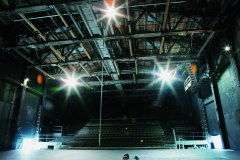The Blizzard
August 2025 | ||||||
|---|---|---|---|---|---|---|
Mo | Tu | We | Th | Fr | Sa | Su |
After Vladimir Sorokin (1955)
The Blizzard
In a version by Kirill Serebrennikov
World premiere
In German with English surtitles
‘And suddenly, he realized that the journey had not ended happily and that something new was beginning.’
When asked about his text, the author offers an answer that looks to the future. ‘I love snow. A blanket of snow covers the earth and makes everything beautiful. There are the upheavals and all the contradictions of our everyday lives, and then it snows and the world is beautiful,’ says Vladimir Sorokin when talking about his novella. Like works by Pushkin and Tolstoy, it carries the title Метель (The Blizzard) and, at first sight, reads like an intertext distilled from the Russian snowstorm tradition. ‘If you’re outside and get caught in a blizzard, that’s it. It’s a beautiful phenomenon, but also a terrible, fateful event. My story really has three protagonists: the doctor, his coachman and the blizzard. The third one wins out in the end.’
Much like the beauty of a snowy landscape, the 19th-century language in which Sorokin writes is also an illusion. The referential framework, character relationships and narrative style of his visionary writing initially lead the reader astray. The post-apocalyptic odyssey of Garin, a doctor who wants to bring a vaccine to a remote village where a mysterious plague is turning the inhabitants into zombies, takes place in the future.
On a retrofuturistic carriage ride through a vast white landscape — nothing in sight but snow — characters and readers alike lose all sense of distance and time. They come face to face with grotesque beings, giants and dwarfs, and experience erotic escapades and drug-fuelled hallucinations. These are so frightful that a simple life seems worth living again. The journey peters out, the catastrophe is put on hold and the mission goes unfulfilled.
The existential road novel culminates in a final showdown with the blizzard. A remarkable twist at the end hints at something new heading our way, something that will stretch our collective imagination to breaking point: the half-frozen doctor and his dead coachman are discovered by none other than the Chinese. Chinese collectors, who gather up anything vaguely usable, only to move on indifferently and leave this place of failure to the endlessly falling snow. But where do they take their spoils? And what comes after the end of the world as we know it?
When asked about his production, the director responds with a fragmentary montage of images: ‘Snow. Small horses. A glass pyramid. The path. Infinity. Longing. Storm. The nothing. Dream. Deception. Wind. Giants. Darkness. Doubt. Frozen time. Mistake. The lost world. Zombies. The vaccine. Destiny. Struggle. Death. Ice space. Redemption?‘
In Serebrennikov’s production as in Sorokin’s text, the blizzard is the main character. It has many voices, most of them female. It leads the way, sometimes into temptation. It scolds, dances, sings, withdraws into silence and raises momentous questions. It casts coldness over everything, along with a pall of sleep that must not be surrendered to. It takes us to the epicentre of a blinding brightness. Whiteout conditions. The horizon disappears; earth and sky merge as one. The world as we know it, colours and shapes all disappear; landmarks, contrasts and contours are dissolved. We find ourselves in the middle of a completely empty white space, infinitely expansive, and lose our balance.
This dizzying state of absolute disorientation defines the atmosphere of Kirill Serebrennikov’s production. An existential cabaret that plunges the audience into a world spinning out of control.
Where is down, where is up?
Where should I go?
Why go on at all?
How will it end?
With death or salvation?
Birgit Lengers
Vladimir Sorokin has been hailed as one of the most significant Russian writers of the last few decades and is among the most outspoken critics of the Russian state and its war against Ukraine. The internationally acclaimed director Kirill Serebrennikov was artistic director of the Gogol Centre in Moscow. After the large-scale invasion of Ukraine, he left Russia and is now based in Germany. In 2023, he founded his theatre company KIRILL & FRIENDS in Berlin.
Translation: Sebastian Smallshaw
Program and cast
August Diehl - Dr. Garin
Filipp Avdeev - Perkhusha
Sonja Beißwenger
Yang Ge
Malika - Maminova Marimba, Vibraphone, Percussion
Belendjwa Peter
Frol Podlesnyi - Live Camera
Mikhail Poliakov - Keyboard
Varvara Shmykova
Claudius Steffens
Kirill Serebrennikov - Director, Sets and Costumes
Vlad Ogay - Sets and Costumes
Alexander Manotskov - Music
Daniil Orlov - Conductor
Evgeny Kulagin, Ivan Estegneev - Choreography
Ilya Shagalov - Video Design
Sergej Kuchar - Lighting Design
Viacheslav Kasianov - Sound Design
Alina Aleshchenko - Artistic Production Manager
Birgit Lengers, Anna Shalashova - Dramaturgy
Elizaweta Veprinskaja - Assistant Sets and Costumes
A co-production of the Salzburg Festival with the Düsseldorfer Schauspielhaus and KIRILL & FRIENDS Company
Perner-Insel, Hallein
Perner-Insel, Hallein
“White Gold” (salt) was extracted for four thousand years near Hallein and this is what gave the region and the capital of the province its name. In 1989 the salt works were closed down. Various influential people involved in cultural life took the initiative to have the brine hall on the island in the middle of the River Salzach transformed into a theatre which is now used regularly by the Salzburg Festival. The conversion work in 1992 needed only an 80-day building period; six years later, new, more elaborate seating arrangements were installed as well as an interval area.
The hall is especially suitable for experimental theatre and concerts of contemporary music whereby the performance and audience areas can be adapted to the scenic concept of the production in question. In 1999 the marathon performances entitled Schlachten!, Luc Perceval’s interpretation of Shakespeare’s history plays, on the Perner Island achieved cult status.
How to get there
Adress & contact
Perner-Insel, Hallein
Pernerinsel, 5400 Hallein
The foyers are opened to Festival visitors one hour before the beginning of each performance.
Tel.: +43 662 8045 0
info@salzburgerfestspiele.at
Public transport
Bus stop Heidebrücke
Lines 41, 160, 170
FREE BUS SHUTTLE SERVICE
Departure in front of Reichenhaller Strasse 4
(Buses depart to Perner-Insel, Hallein, 1h before the performance begins and return directly after the performance.)
Parking
Parking place Perner-Insel
Perner-Insel, 5400 Hallein
Opening hours: daily 0-24 h
You can purchase a parking ticket for 2€ in the courtyard. By purchasing your parking ticket there, you save yourself the way to the ticket machine and can immediately drive out the parking lot following the end of the performance.

 EN
EN DE
DE IT
IT FR
FR ES
ES RU
RU JP
JP RO
RO
 Seating plan
Seating plan 